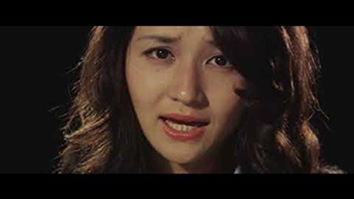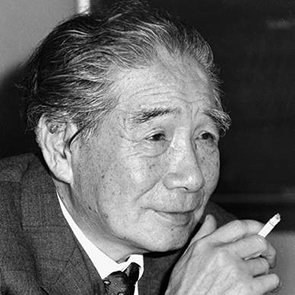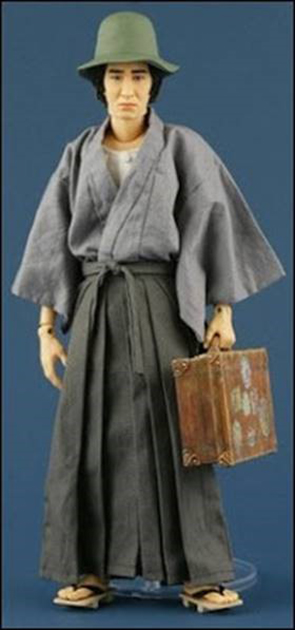This is a fantastic mystery that is immediately engaging and stays engaging right to the end, making it a very quick read. And it’s a genuine locked room mystery!
The eldest son of the Ichiyanagi family marries a beautiful and intelligent young woman. On their wedding night, long after everyone has gone to bed, the household is suddenly woken by screams coming from the annexe where the newlyweds are spending the night. The screams are followed by the sound of a kobo (a traditional Japanese musical instrument) being played. Everyone rushes outside to the annexe only to find the door to the annexe locked. Several walk fully around the annexe seeking a way in and eventually use an axe to break through a locked shutter. Inside they find the dead bodies of the bride and groom, and no one else. It has been snowing earlier, and while in walking around the annexe, they have already found a bloody katana thrust into the snow and have noted that the snow on the ground is completely unmarred by footprints. The bride and groom have obviously been murdered (the weapon found outside some distance from the locked building shows it wasn’t suicide) but it is impossible to see how the murderer could have left without being seen and without leaving any trace in the snow. The local police have several suspects but are baffled as to how it could have happened. Luckily, the uncle of the bride knows a talented detective (Kosuke Kindaichi) and summons him to help. The solution to the mystery is ultimately simple, but also extremely shocking when we learn the motive.
This mystery is set in 1937, but the story is told to us by the author in 1946. The author explains that he wants to write a book and has chosen this true crime as the basis for his story. The fourth wall breaking adds to the intimacy of the story, giving it an immediate impact, as if we’re watching a performance, as the author visits the scene of the crime, talks to witnesses and, at the end, explains how he structured his story to let us deceive ourselves: a trick he learned from Agatha Christie, he tells us.
This was one of the things that I loved about this book, all the references to classics of the Golden Age, mostly to classic locked room mysteries, but also to stories like The Murder of Roger Ackroyd, where the reader doesn’t understand the full significance of what has been read until all is revealed at the end. Apart from the writing style, the classic mysteries referenced by Yokomizo also become significant to the solving of the mystery. And even if they do nothing else, they've given me a few extra names to add to the list of classic mysteries I want to read.
A huge part of the book is its exploration of the impact of a rigid class system. The story is told from a post-war point of view of pre-war society in Japan. Japan was, at this point, slowly emerging from a feudal society. The book describes how the traditions of Edo society were already fading in cities such as Tokyo but still lingered in rural areas such as the setting for this book.
The Ichiyanagi family had owned a Honjin, a high status inn used by representatives of the Shogun and feudal lords. This gave them a high social status. Once the Shogun/Edo society began to collapse and the imperial system reinstated, the Ichiyanagi family bought large tracts of land to build an estate, and became the wealthiest landowners in the village. At the beginning of the book, they are known for their pride and wealth, they consider themselves the high-status family of the district, even if local folk call them “a bunch of upstart kappa.” The obsessive pride some members of the family have for their social position and family standing are important to the plot. The marriage of Kenzo, the oldest son and heir to Katsuko, daughter of a farmer, has resulted in a lot of gossip in the village and has created frictions in the family. Marriage is meant to be used as a means to increase social standing, wealth and/or landholdings. The Ichiyanagi think they deserve the “reverence, respect and pride associated with being born into a family with a distinguished ancestry” and consider Katsuko to have “no family name, no pedigree.” In short, she is unsuitable as a bride to the eldest son, so thinks everyone except for said eldest son who appreciates her education and intelligence. All of this focus on lineage and worth is what ultimately leads to the murder.
The detective, Kosuke Kindaichi, is a wonderful creation and a brilliant detective. He is a Japanese equivalent to Sherlock Holmes or Hercule Poirot, an eccentric who pays little attention to societal norms, who dresses strangely, has a slight stammer and behaves oddly, but who also observes tiny details and makes quick deductions. Three books featuring him have been translated into English over the last few years (published by Pushkin Vertigo), with another is due out next year. Yokomizo actually featured him in 77 novels between 1946 and 1980, so there are many more books for Pushkin Vertigo to draw upon. Like Holmes, he has spawned more stories since his creator’s death, with spin-off characters such as Hajime Kindaichi who is the supposed grandson of Kosuke Kindaichi, and who features in his own manga series. You can even buy action figures of him (see the sidebar!).
I thoroughly recommend this mystery. I loved the story, I loved the reveal and reasoning, and I love the detective. I intend to read more of this series.
The Honjin Murders was filmed in 1975 under the title Death at an Old Mansion. The complete film is featured on YouTube. YouTube has a content warning for this video, explaining that This video may be inappropriate for some users.
As a result, the film is only available on YouTube. If you wish to view it, click on the image above.
 RSS Feed
RSS Feed Facebook
Facebook Instagram
Instagram YouTube
YouTube Subscribe to our Newsletter
Subscribe to our Newsletter







